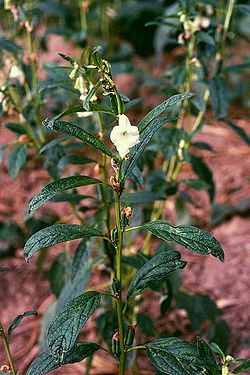Sesamum
| Habit | herbaceous
| |
|---|---|---|
| Lifespan: | ⌛ | perennial, annual |
| Features: | ✓ | flowers |
|---|
|
Sesamum > |
If this plant info box on watering; zones; height; etc. is mostly empty you can click on the edit tab and fill in the blanks!
Sesamum is a genus of approximately 20 species in the flowering plant family Pedaliaceae. The plants are annual or perennial herbs with edible seeds. The best-known member of the genus is sesame, Sesamum indicum (syn. Sesamum orientale), the source of sesame seeds. The species are primarily African, with some species occurring in India, Sri Lanka, and China. The origin of S. indicum is uncertain as it is widely cultivated and naturalized in tropical regions. The genus is closely related to the strictly African genus Ceratotheca and is itself probably African in origin.
Read about Sesamum in the Standard Cyclopedia of Horticulture
|
|---|
|
Sesamum (Greek name taken by Hippocrates from the Arabic). Pedaliaceae. Herbs, erect or prostrate, scabrous or rarely glabrous, suitable for the warmhouse, and for the open in the S.: lowest lvs. opposite, the upper and almost all alternate, petioled, entire, incise-dentate, 3-cleft or pedately cut: fls. pale or violet, solitary in the axils; calyx rather small, 5-parted; corolla-limb 2-lipped and 5-lobed; stamens 4, didynamous; ovary 2-celled: caps. oblong or ovoid.—About 20 species, Trop. and S. Afr., E. Asia. The only species of importance is S. indicum, which has been extensively cult. in the tropics from ancient times. The seeds are sold in Amer. under the name of bene. They yield about half their weight of oil-of-sesame (known also as benne-, gingili-, or teel-oil), which is odorless and does not easily become rancid. This oil is universally used in India for cooking and anointing. Large quantities of oil and seed are imported from India to Eu. for the manufacture of soap and adulteration of olive-oil. Also cult. in northern states as a medicinal herb, the mucilaginous lvs. being used in dysentery and diarrhea of children. The oil of sesamum, however, which is expressed from the seeds is in large doses a laxative. CH
|
Cultivation
Propagation
Pests and diseases
Species
Gallery
References
- Standard Cyclopedia of Horticulture, by L. H. Bailey, MacMillan Co., 1963
External links
- w:Sesamum. Some of the material on this page may be from Wikipedia, under the Creative Commons license.
- Sesamum QR Code (Size 50, 100, 200, 500)




